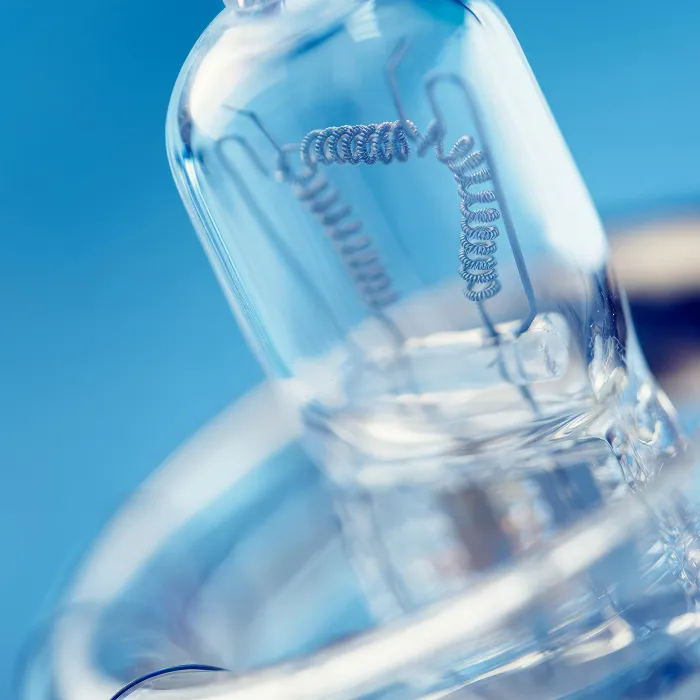Alternatives?
In addition to the devices listed last, there are of course many other flash units that are suitable for indoor and outdoor use to varying degrees. If you are prepared to accept compromises in the range of functions and ease of use, you can either buy an outdoor flash unit, which can then also be used indoors - with some compromises. Or you can buy a studio flash unit which - with the help of external battery packs - can occasionally be used outdoors.
Figure 6.1: Shown here are three powerful battery generators with either 1,200 WS (Hensel Porty and broncolor mobil) or even 2,400 WS (broncolor verso A4). With a weight of approx. 26 kg (generator plus battery), the broncolor verso is very heavy, but has a very high capacity and a maximum output of 2,400 WS. Ideal for longer outdoor advertising photo shoots, provided the equipment can be delivered by car.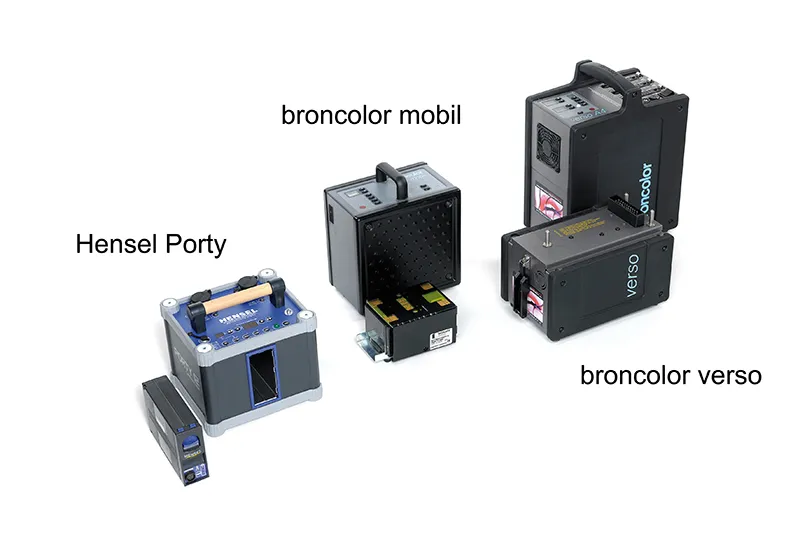
(Photo ©: Jens Brüggemann - www.jensbrueggemann.de)
6.1 Using outdoor flash units indoors too
I have been working with two different outdoor generators for years. In addition to the "mobil" from broncolor, I also use a "Porty Lithium 1200" from Hensel. Both are also suitable for the studio - with restrictions.
Hensel Porty Lithium 1200
A great battery-powered flash unit for outdoor use: the Hensel Porty Lithium 1200 with flash head, standard reflector, light cable and tripod. Always use the most stable, air-damped tripods possible (in the studio and especially outdoors)! If the flash head falls down and the protective glass, flash tube and modeling light break, it's an expensive affair ...! It is better to spend a few euros more from the outset on sensible tripods that reduce the risk of the flash head tipping over or accidentally being knocked down. (Photo © 2013: Jens Brüggemann - www.jensbrueggemann.de)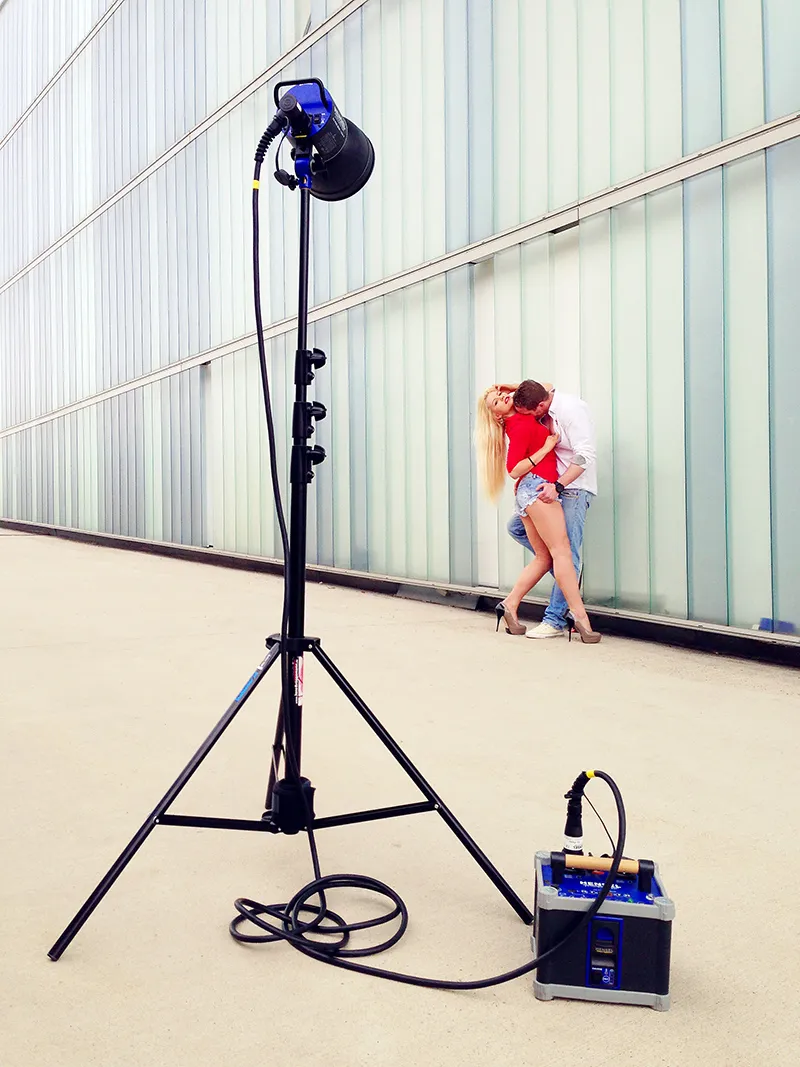
Figure 6.2: The Hensel Porty Lithium 1200 is relatively light (5.9 kg), powerful (1,200 WS), offers a high light output (up to 220 flashes at full power of 1,200 WS) and is pleasantly fast in terms of flash frequency.
It has a wide control range of 7 f-stops and has two lamp connections that can be controlled asymmetrically (but in fixed ratios, not completely freely).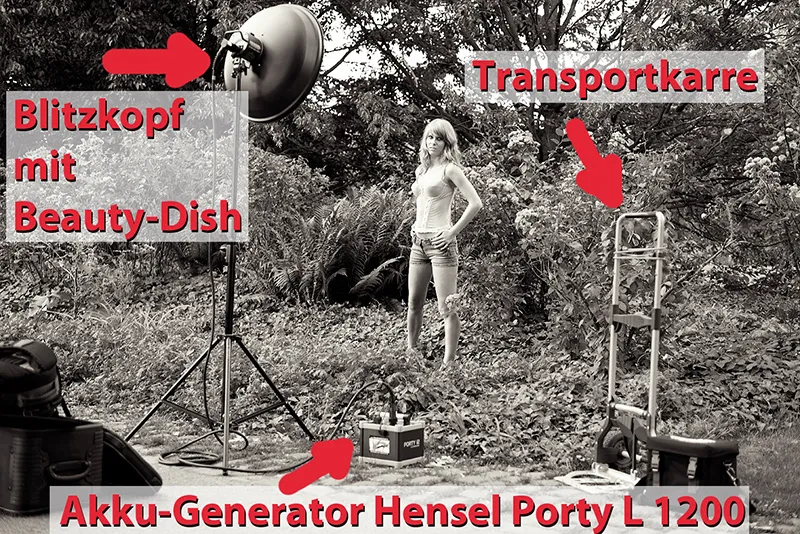
(Photo ©: Jens Brüggemann - www.jensbrueggemann.de)
Figure 6.3: The "Porty Lithium" was the first lithium battery generator on the market and has been one of the top battery generators since its launch. Its reliability (it is "Made in Germany") makes it popular with photographers, even if they had not previously worked with Hensel lighting equipment. By using the "AC Porty power supply plug-in unit", the mobile generator becomes an (almost) fully-fledged studio generator. This power supply unit even enables 650 watts of modeling light, which is an excellent value even for professional requirements.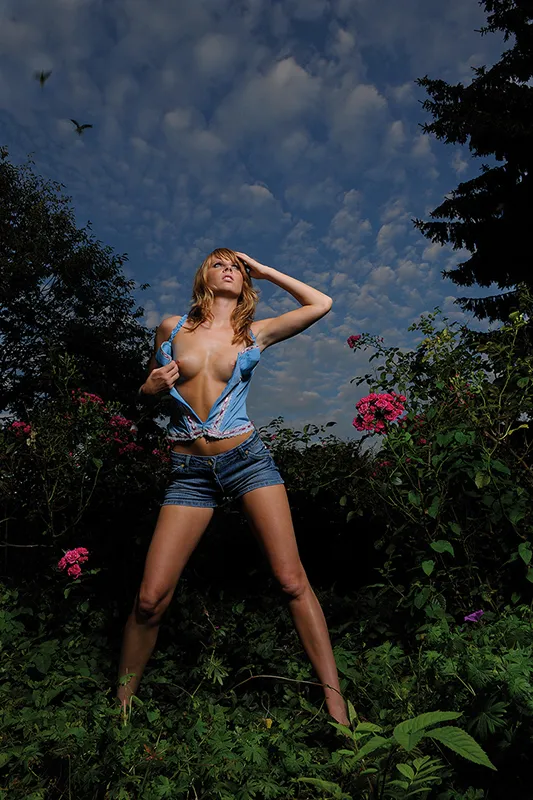
(Photo ©: Jens Brüggemann - www.jensbrueggemann.de)
Figure 6.4: In addition to the evening light (the photo was taken on August 1, 2009 at 6:30 p.m.), I only used a flash head from the front right here. I used the beauty dish with white inner coating from Hensel as a light shaper.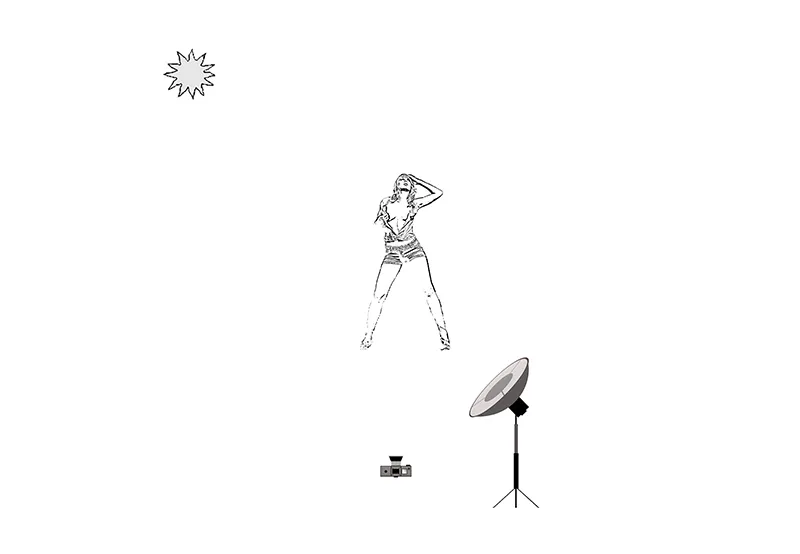
Conclusion: The Hensel Porty Lithium 1200 is a reliable, fast and proven outdoor generator with a high capacity. Thanks to its mains adapter, it can also be used well in the studio. However, it only has two lamp connections and there are limitations in the asymmetrical control, which is why it can only be used for frequent studio applications if it is supplemented by additional flash units.
broncolor mobile
In addition to outdoor use, the "mobil" from broncolor (1,200 WS maximum output with unfortunately only 4 f-stop control range) can also be used as a studio generator with the help of the power supply unit, which is inserted into the bottom of the unit instead of the lead-gel battery. Although it has two light connections, these cannot be regulated asymmetrically, but only equally (symmetrically). The total energy is therefore distributed between the two lights (if two lights are connected); otherwise, if one light is connected, it receives all the energy.)
Conclusion: I only use the "mobil" from broncolor (with power supply unit) as a supplement in the studio, for example when I need "a lot" of light for interior shots. Low control range, slow charging times and only symmetrical control of the two lamp connections make it too inflexible to be used as a studio generator on its own. I still appreciate it as an outdoor generator thanks to its output of 1,200 WS and its low weight, although I still have the old version.
The newer A2L version with lithium battery has become somewhat faster and allows asymmetrical control of the power distribution to the two lamp connections; however, only in a ratio of 70:30 or 80:20 (lamp output 1:lamp output 2).
broncolor move 1200 L
broncolor's new "move" mobile power pack with a maximum output of 1,200 watts (shortest flash time up to 1/20,000 of a second) is much more flexible and attractive. Weighing just 6.2 kg (incl. lithium battery), it offers full asymmetry of the two lamp connections. It is also particularly attractive because of the trolley backpack and weatherproof generator bag included in the scope of delivery. The 9 f-stop control range makes it flexible to use, even in the studio. The lithium battery can withstand up to 4,000 charging cycles. The battery can be recharged in just 1.5 hours.
In speed mode, the "move" is very fast (according to the manufacturer, the charging time is then 0.02-0.9 seconds). However, this is at the expense of maximum power: in speed mode, "only" 600 WS is achieved (1 f-stop below maximum power). However, the principle of the "speed mode" has the advantage of being able to use a very strong flash output if required or, alternatively, to be able to flash very quickly one after the other (then with one f-stop lower output).
Figure 6.5: The "move 1200 L" can be operated with the MobiLED LED light with an LED modeling light of 2x30 watts (roughly equivalent to 2x150 watt halogen modeling light). This makes it interesting for use in mixed light. (Or also for video filmmakers). This continuous light mode can be operated for up to 2 hours.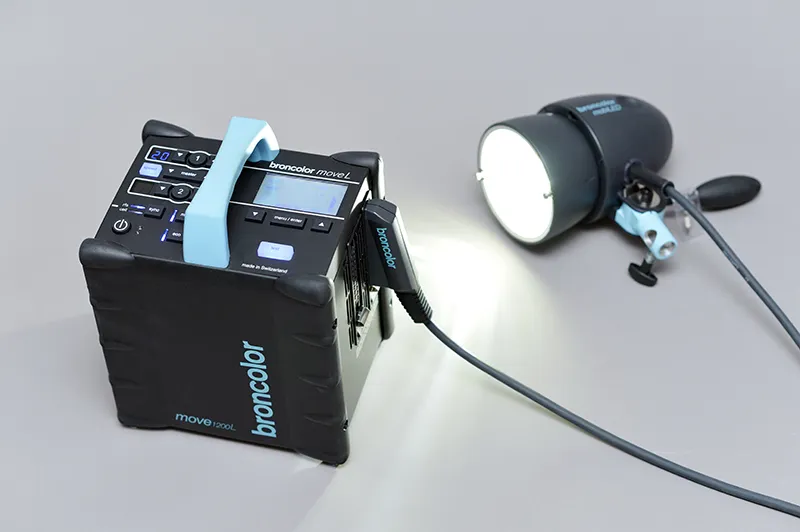
(Photo © 2013: Jens Brüggemann - www.jensbrueggemann.de)
Figure 6.6: The backpack trolley included in the scope of delivery is particularly practical. It can be carried on the back or pulled along. When filled, it is not exactly "child's play" - but at least it is easy to handle.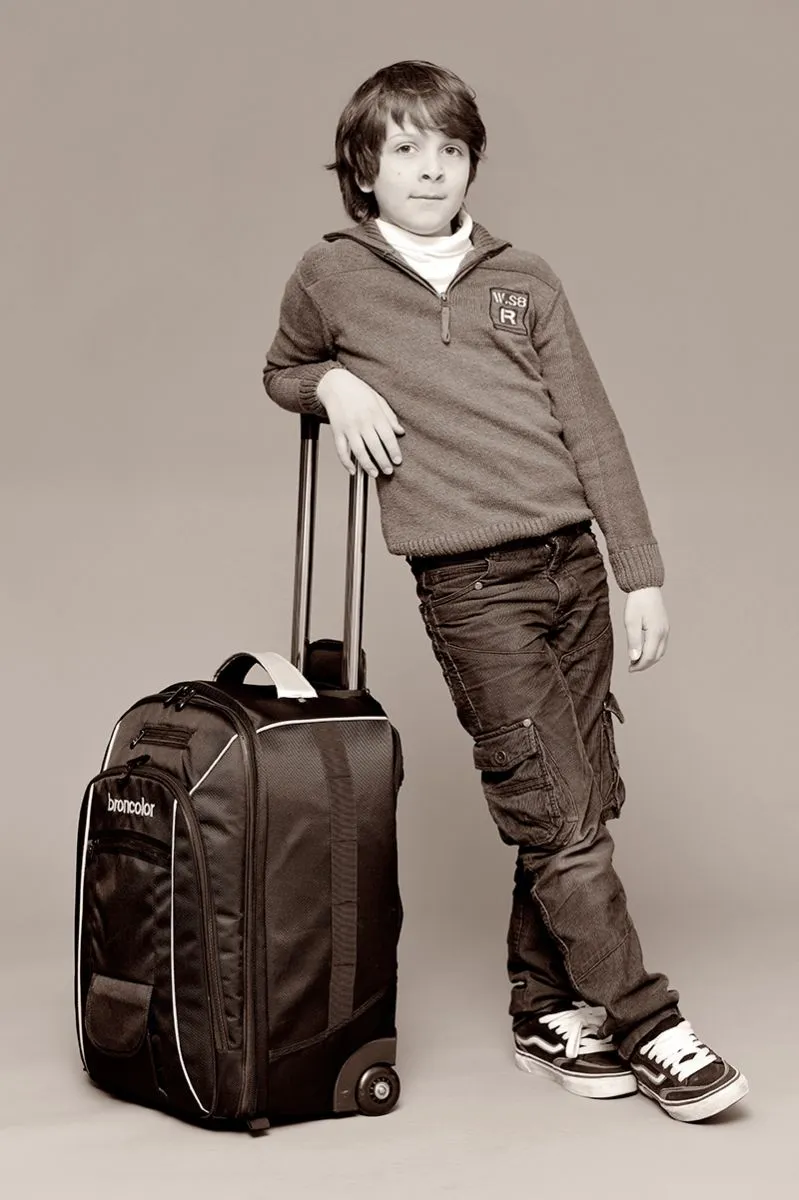
(Photo © 2013: Jens Brüggemann - www.jensbrueggemann.de)
Similar to the Profoto "Pro-B4", the "move" can also be loaded during operation. However, from a technical point of view, this procedure is not necessarily recommended. It is more likely to be classified as an "emergency solution": possible, but not sensible (for reasons of battery longevity).
This is because, unlike with a mains adapter, where the current is fed through, charging the battery during operation also puts a strain on it. The question also arises as to whether this is necessary at all: if the batteries are fully charged, a smaller shoot can certainly be completed with one battery charge. For larger shoots, it is better to use the breaks between shoots to recharge the batteries. Or purchase a replacement battery for 600 euros plus VAT.
Conclusion: The "move" from broncolor is a flexible generator for outdoor photography. When used together with the MobiLED light, a powerful LED continuous light can be operated for up to 2 hours in continuous light mode. Interesting for photographers who also offer videos.
Although the "move" can be used as a studio generator, two light connections will not be enough in the long term. At the very least, 1-2 additional flashes must be purchased. However, this shortcoming not only affects the "move", but all battery-powered generators. After all, they are designed for outdoor use. There are other (more suitable) studio generators from all manufacturers for studio use.
The battery pack is said to last a very long time (up to 4,000 charging cycles), but for frequent studio use, a mains adapter that can be used instead of the battery would be desirable.
The price of 3,990.00 Euro plus VAT (= 4,748.10 Euro gross) is quite high, but considering the performance values of this power pack (especially the individual asymmetrical control over 9 f-stops) and adding the usual reliability of a broncolor product, the purchase is definitely a sensible long-term investment.
6.2 Using studio flash units outdoors too
broncolor verso A4
I own several studio generators. One of them, the verso A4 from broncolor, is designed so that it can be used not only as a fully-fledged studio generator, but also as a high-quality, "mobile" battery-powered generator. Whereby "mobile" is not necessarily to be taken literally, but rather theoretically, as the generator plus battery pack together weigh approx. 22.7 kg (which does limit the actual mobility).
It has three light connections, whereby the individual (asymmetrical) power distribution only takes place via two channels (the power from channel 2 is distributed symmetrically across lights 2 and 3). With its 2,400 watts of power, it is also ideally suited for interior and automotive photography. It supports 650 watts of modeling light and has a control range of up to 8 f-stops (adjustable in 1/10 f-stops).
Unfortunately, it takes a very long time to reach the new power setting (0.3 - 3.2 seconds, depending on the power output and mains/battery operation) when the power is changed, which can be indicated by a beep if desired.
Figure 6.7: For easier ("weight-balancing") transportation, the Power Dock (right in the picture) can be carried using the handle included in the scope of delivery. For battery operation, the Power Dock is placed under the generator and secured with the clamps.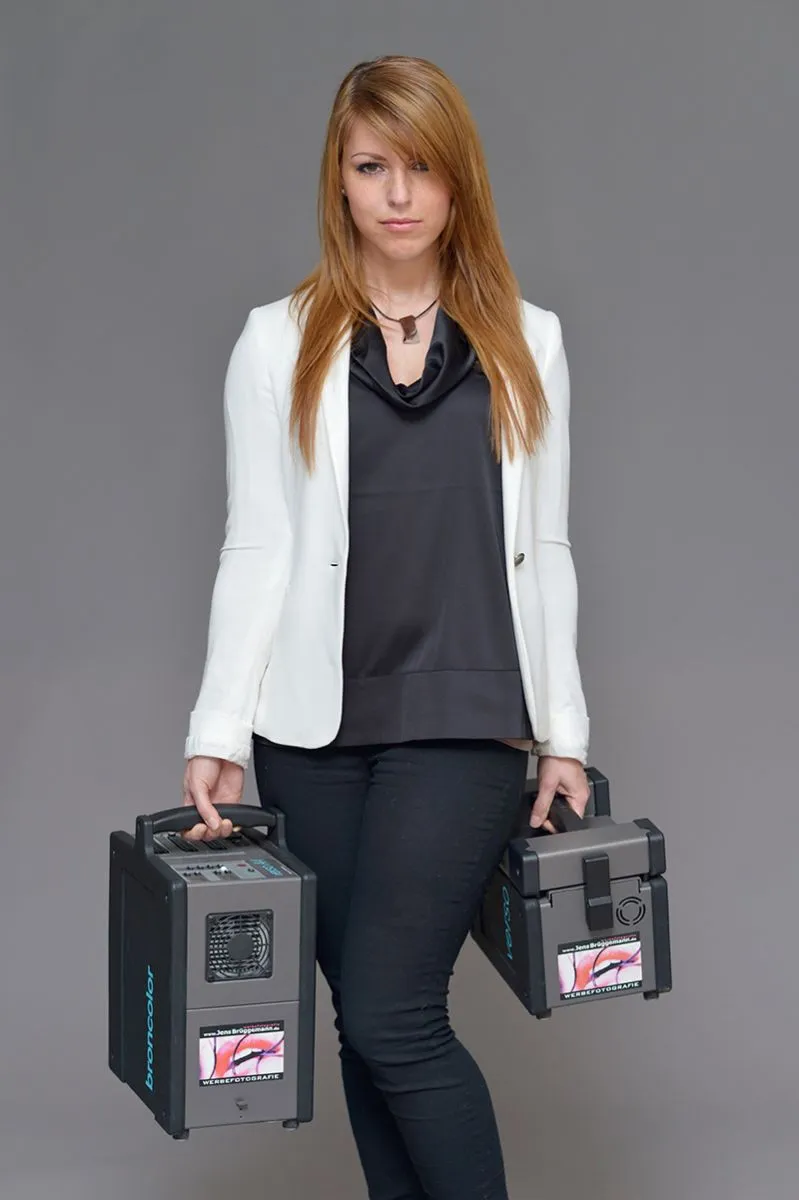
(Photo © 2013: Jens Brüggemann - www.jensbrueggemann.de)
In order to be used as an outdoor generator, the (at approx. 12.3 kg quite heavy) battery pack called "Power Dock" (lead-gel batteries are used, by the way) is attached to the bottom of the device using two clamps. With fast charging and full flash power (a whopping 2,400 watts!), up to 180 discharges can be achieved with this power dock. "With normal charging at 1,200 J, you can even achieve almost 450 flashes," says the manufacturer. According to the manufacturer, it takes 3 hours to recharge the discharged battery to 80% of its full charging capacity.
Its focus on a fully professional target group is also reflected in the price: The Verso A4 costs €7,430.00 plus VAT (= €8,841.70 gross), while the "Power Dock", available as an accessory, costs a further €1,790.00 plus VAT (= €2,130.10 gross).
The "verso" is available in two different versions: with 1,200 WS (then costs "only" 5,490.00 euros plus VAT = 6,533.10 euros gross) and with 2,400 WS power. (broncolor 2013 price list)
Conclusion: The "verso" is a fully-fledged, robust studio generator that can also be used on location with a battery pack. However, due to the enormous weight of the generator and power dock, it will probably only rarely be used outdoors. Only if there is the possibility of delivery by car will it be dragged along on important photo shoots.
Bowens Gemini
Bowens has a successful compact flash series called "Gemini", which is very popular with semi-professional photographers and beginners. These are available with different maximum outputs: From 1,500 WS for the most powerful unit down to 200 WS power for the weakest. The "Gemini Pro" and "Gemini R" series are particularly recommended due to their good price-performance ratio and professional standard.
Figure 6.8: The devices in the "Gemini" series are particularly popular with newcomers. This is due to their low purchase price and wide range of options. Unfortunately, the control range of the weaker devices is quite small (5 f-stops; 7 f-stops for devices with an output of 1,000 watt seconds or more). A portrait photographer who wants to work in a smaller studio (with little space, which leads to a small distance between the lights and the model) and with an open aperture will have a hard time realizing this because the flashes cannot be set weak enough due to the control range.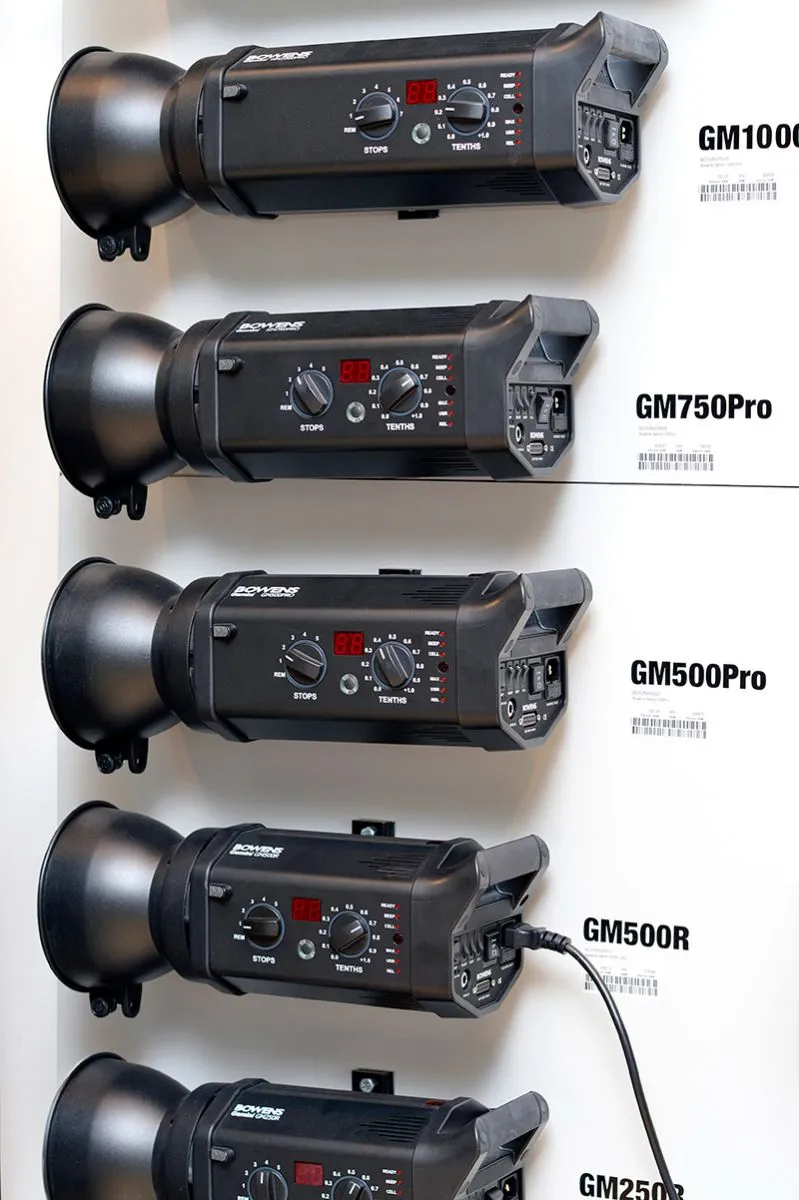
(Photo © 2013: Jens Brüggemann - www.jensbrueggemann.de)
The popular "Travelpak" battery packs, which are compatible with all devices in the Gemini series, are available as accessories for outdoor flashes. "A maximum of two flash heads with up to (a total of) 3000 W/s can be supplied." The weight is specified by the manufacturer as 3.5 kg for the small and 4.9 kg for the large battery pack.
However, the weight of the control panel must be added to both (+ 1.5 kg). The capacity depends on the number of powered flash heads (1 or 2) and the power setting. For example, the capacity varies between 750 flashes (for the large "Travelpak" with one flash and only 200 WS power output) and 25 flashes (small "Travelpak" with two connected flashes and 1,500 WS power output each).
Figure 6.9: Also interesting for young photographers: compact flash units from the "Gemini" series are designed for use in the studio. However, if you use the optional "Travelpak" (the smaller version is shown here), two "Gemini" units can also be operated independently of the mains supply.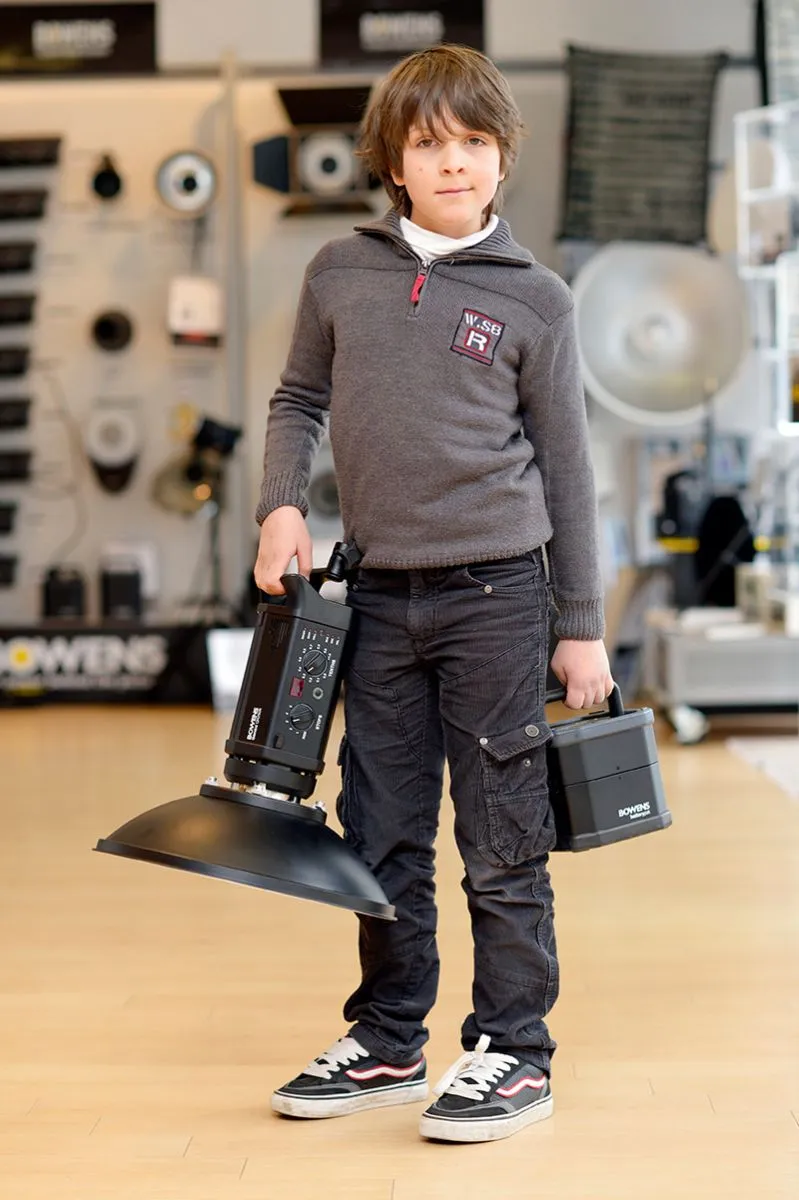
(Photo © 2013: Jens Brüggemann - www.jensbrueggemann.de)
The charging cycles can be classified as slow. They are between 2 and 30 seconds (depending on the number of compact flash units supplied and the set power output).
The price is a moderate 1,007.56 euros plus VAT (= 1,199 euros gross) for a 2-device set (Gemini 250 R) including tripods, radio trigger, set bag and light shapers (1 softbox, 1 umbrella reflector). Viewed at Calumet, April 2013.
Conclusion: The charging cycles of the two "Travelpaks" from Bowens, which supply the compact flash units of the "Gemini" series with power independently of the mains supply, can be classified as slow. They are between 2 and 30 seconds (depending on the number of compact flash units supplied and the set power output). The control ranges are also not really professional: Only 5 f-stops on the smaller units; 7 f-stops on the units with 1,000 WS or 1,500 WS. For portrait photographers, it will be difficult to stop down the power so far that shots with an almost open aperture are possible.
Nevertheless, the "Gemini" compact flash units are very popular with newcomers and semi-professional photographers, which will primarily be due to the price. The ability to use this studio flash unit outdoors will also be a deciding factor for many.
Profoto D1
If you want to go down a similar route, but want to go upmarket, I recommend the Profoto compact flash units from the "D1" series. They are robust, reliable and offer a control range over 7 f-stops, which also makes them interesting for professional users. They have a very fast flash recycle time and can be operated with 300 watts of modeling light. Two units with 250 watt-second output each in the "Profoto D1 Studio Kit" including kit case, two flash umbrellas and two lamp tripods cost 1,599 euros plus VAT (= 1,902.81 euros gross).
Figure 6.10: The "D1" and "D1Air" compact flash units from Profoto are very popular with beginners and professional photographers. Robust quality, a wide control range and an extensive range of light shaping accessories make this flash system attractive. However, the flash tube is recessed in the front of the housing, it does not protrude and cannot radiate to the side, which should generally make the light somewhat more directional (compared to other systems).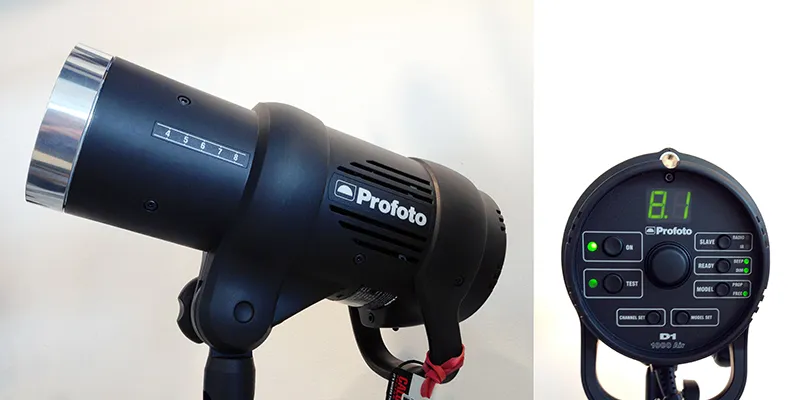
(Photo © 2013: Jens Brüggemann - www.jensbrueggemann.de)
If you purchase the "Profoto BatPac" (a combination of a special inverter and a high-performance battery), you can also work excellently outdoors with the Profoto D1 compact flash units. The BatPac has two sockets (to which other devices such as laptops etc. can also be connected up to a maximum power consumption of 600 watts). Its capacity when fully charged is said to be 600 flashes when using a 500 watt-second compact flash unit.
This would also mean 600 flashes (per unit) for two units with 250 watt seconds each. The Profoto BatPac including bag and battery costs 1,049 euros plus VAT (= 1,248.31 euros gross). (Prices: Calumet Photographic GmbH, April 2013.)
Conclusion: The Profoto D1 series satisfies even fully professional requirements thanks to the large control range of 7 f-stops and the strong modeling light for compact flash units. The units are robust and the use of the BatPac means they can also be used on location, independent of the mains supply. Recommended purchase for photographers who are still reluctant to enter the more expensive flash unit generator class!
Summary
The trend in flash units is clearly moving towards mobility. The differences between pure studio flash units and battery-powered flash units are becoming blurred. Photographers want (or need) to be flexible, and the demands on equipment are increasing accordingly.
For many flash systems, there are already options for using them both indoors and outdoors. However, there are usually compromises (in terms of operation, modeling light intensity, charging cycles, control range, weight, etc.).
In my opinion, the Profoto Pro-B4 and the battery-operated compact flash units from Priolite (see tutorial 5 in this series) are best suited to cover both areas of use. The broncolor "verso" can also be used both indoors and outdoors. However, it is too heavy to be described as a "mobile generator".
The design focus of the other devices presented here is noticeable: Either they are designed for the studio; in which case their use outdoors is often possible, but not "elegant" (only possible with restrictions). Or they have been designed as outdoor flash units, in which case their use in the studio is potentially feasible, but not comfortable enough compared to "real" studio generators.
Even if I have unfortunately not been able to present all the interesting devices on the market here, I hope I have given you a feel for what is important when purchasing a flash system.
If you can't spare the high purchase price for the Profoto "Pro-B4" (including flash heads and accessories) and shy away from purchasing the Bowens "Gemini" compact flash units including "Travelpak" due to their small control ranges or slow charging cycles, you will either end up with the "D1" compact flash units from Profoto or have to continue to rely on the usual solution for the time being: The purchase of two different (!) flash systems (one for the studio and one for use away from the socket).
Financially and for reasons of flexibility, this may (still) be the most sensible solution. Especially if you want to work with more than just two light connections in the medium term, which is inevitably the case more often in the studio for advertising shots.
Conclusion
The purchase of a flash system should definitely be seen as a long-term investment. It is not for nothing that photo retailers often offer financing options for flash systems. Unlike DSLR cameras of the last 15 years, flash systems do not become obsolete so quickly. If you buy something of higher quality instead of inferior equipment, you will unfortunately have to spend more money, but you can be sure that you will not only be able to work with the equipment for 1-2 years, but for much longer.
Systems from premium manufacturers can easily be used for 25 years (or even longer) without any restrictions. If you take this into account and allocate the purchase costs to the useful life, it becomes clear that more expensive but higher-quality devices can perform better than supposed "bargains" bought online! The high purchase price of high-quality products is then not so high when calculated over the years.
Another point that should be considered is the resale price of used flash units. Particularly professional, reliable and robust flash units (as well as the corresponding accessories) still achieve astonishingly high prices when resold. Just have a look on eBay to see what used units from broncolor or Profoto, for example, cost! They often go for higher prices than their purchase prices were years ago (which is due to the fact that the units are particularly durable and sometimes cost several times more today than they did years ago due to price increases).
So if you buy a high-quality flash unit and treat it with care, you will still get good money for it years later - when you no longer need it. Cheap flash units, on the other hand, will neither (be able to) last long nor achieve particularly attractive resale prices. In the worst case, the electronic waste will have to be disposed of for a fee.
In general, the robustness of devices that may not only be used in the studio, but also outdoors, is another decisive purchase criterion: What use is a cheap flash system if the housing shell of the flash head bursts open immediately at the slightest impact? Or if the electronics inside come loose and are damaged by vibrations?
"Buy cheap, buy twice!" Remember that!
